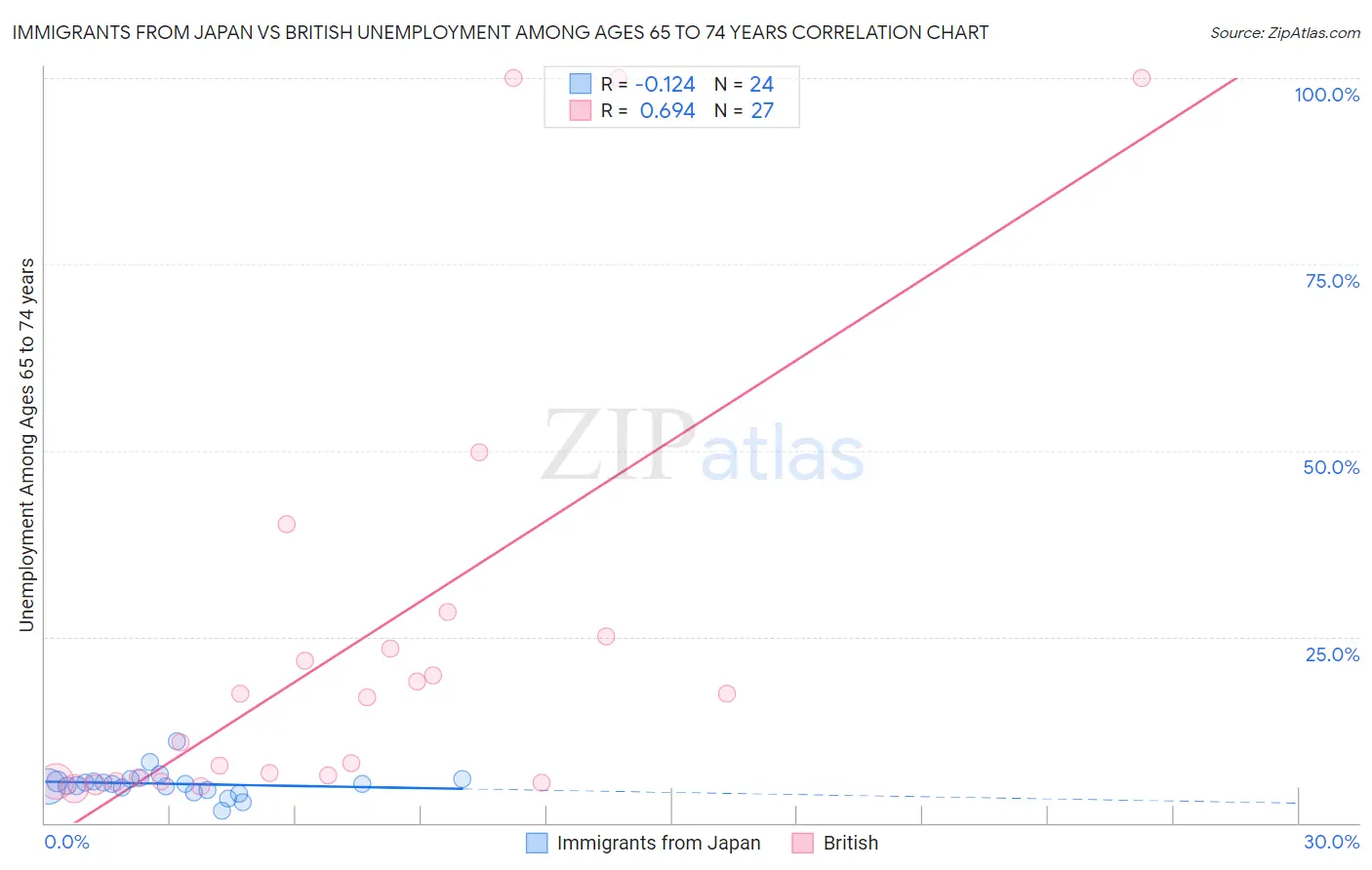Immigrants from Japan vs British Unemployment Among Ages 65 to 74 years
COMPARE
Immigrants from Japan
British
Unemployment Among Ages 65 to 74 years
Unemployment Among Ages 65 to 74 years Comparison
Immigrants from Japan
British
5.2%
UNEMPLOYMENT AMONG AGES 65 TO 74 YEARS
99.1/ 100
METRIC RATING
70th/ 347
METRIC RANK
5.2%
UNEMPLOYMENT AMONG AGES 65 TO 74 YEARS
97.9/ 100
METRIC RATING
85th/ 347
METRIC RANK
Immigrants from Japan vs British Unemployment Among Ages 65 to 74 years Correlation Chart
The statistical analysis conducted on geographies consisting of 305,985,551 people shows a poor negative correlation between the proportion of Immigrants from Japan and unemployment rate among population between the ages 65 and 74 in the United States with a correlation coefficient (R) of -0.124 and weighted average of 5.2%. Similarly, the statistical analysis conducted on geographies consisting of 428,425,960 people shows a significant positive correlation between the proportion of British and unemployment rate among population between the ages 65 and 74 in the United States with a correlation coefficient (R) of 0.694 and weighted average of 5.2%, a difference of 0.77%.

Unemployment Among Ages 65 to 74 years Correlation Summary
| Measurement | Immigrants from Japan | British |
| Minimum | 1.6% | 4.6% |
| Maximum | 11.0% | 100.0% |
| Range | 9.4% | 95.4% |
| Mean | 5.3% | 24.5% |
| Median | 5.3% | 16.8% |
| Interquartile 25% (IQ1) | 4.6% | 5.6% |
| Interquartile 75% (IQ3) | 5.8% | 25.0% |
| Interquartile Range (IQR) | 1.1% | 19.4% |
| Standard Deviation (Sample) | 1.8% | 29.4% |
| Standard Deviation (Population) | 1.7% | 28.9% |
Demographics Similar to Immigrants from Japan and British by Unemployment Among Ages 65 to 74 years
In terms of unemployment among ages 65 to 74 years, the demographic groups most similar to Immigrants from Japan are Scandinavian (5.2%, a difference of 0.010%), Latvian (5.1%, a difference of 0.080%), Swiss (5.1%, a difference of 0.090%), Scotch-Irish (5.2%, a difference of 0.11%), and Immigrants from Oceania (5.2%, a difference of 0.12%). Similarly, the demographic groups most similar to British are Danish (5.2%, a difference of 0.010%), Scottish (5.2%, a difference of 0.010%), Immigrants from Hungary (5.2%, a difference of 0.040%), Immigrants from Middle Africa (5.2%, a difference of 0.21%), and Immigrants from Scotland (5.2%, a difference of 0.36%).
| Demographics | Rating | Rank | Unemployment Among Ages 65 to 74 years |
| Swiss | 99.2 /100 | #67 | Exceptional 5.1% |
| Latvians | 99.2 /100 | #68 | Exceptional 5.1% |
| Scandinavians | 99.1 /100 | #69 | Exceptional 5.2% |
| Immigrants | Japan | 99.1 /100 | #70 | Exceptional 5.2% |
| Scotch-Irish | 99.0 /100 | #71 | Exceptional 5.2% |
| Immigrants | Oceania | 99.0 /100 | #72 | Exceptional 5.2% |
| Filipinos | 99.0 /100 | #73 | Exceptional 5.2% |
| Afghans | 99.0 /100 | #74 | Exceptional 5.2% |
| Okinawans | 99.0 /100 | #75 | Exceptional 5.2% |
| Estonians | 99.0 /100 | #76 | Exceptional 5.2% |
| Immigrants | Sudan | 98.9 /100 | #77 | Exceptional 5.2% |
| Northern Europeans | 98.9 /100 | #78 | Exceptional 5.2% |
| Slavs | 98.7 /100 | #79 | Exceptional 5.2% |
| Immigrants | South Africa | 98.6 /100 | #80 | Exceptional 5.2% |
| Immigrants | Scotland | 98.6 /100 | #81 | Exceptional 5.2% |
| Thais | 98.6 /100 | #82 | Exceptional 5.2% |
| Immigrants | Middle Africa | 98.4 /100 | #83 | Exceptional 5.2% |
| Immigrants | Hungary | 98.0 /100 | #84 | Exceptional 5.2% |
| British | 97.9 /100 | #85 | Exceptional 5.2% |
| Danes | 97.9 /100 | #86 | Exceptional 5.2% |
| Scottish | 97.9 /100 | #87 | Exceptional 5.2% |